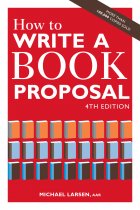 Some writers find it easier to write the book than the proposal, whereas for others writing the proposal is the most creative part of doing a book, according to Michael Larsen in his book How to Write a Book Proposal. Larsen goes on to describe in 42 short and easy-to-read chapters all of the elements of choosing a topic for your book, writing a proposal, deciding whether to self-publish or submit your proposal to an agent or directly to a publisher, and marketing your book.
Some writers find it easier to write the book than the proposal, whereas for others writing the proposal is the most creative part of doing a book, according to Michael Larsen in his book How to Write a Book Proposal. Larsen goes on to describe in 42 short and easy-to-read chapters all of the elements of choosing a topic for your book, writing a proposal, deciding whether to self-publish or submit your proposal to an agent or directly to a publisher, and marketing your book.
In essence, a good book proposal contains:
- An overview, which includes an opening hook, information about the types of people who will want to buy the book, details of the author’s platform, a promotion plan, an analysis of competing books, and information about the author;
- An outline, which provides a short description of every chapter, perhaps including a bulleted list of the information that will be provided;
- One or more sample chapters constituting about 10% of the book, designed to excite editors by demonstrating the author’s writing ability and the marketability of the content.
Many prospective authors will find the book encouraging, while others will find it discouraging. It is encouraging in the sense that all of the steps required for getting a book published are explained in simple terms; it is discouraging in the sense that Larsen makes it quite clear that commercial success is dependent on the author’s marketing skills. Many authors simply want to write a nice book and get someone else to sell it for them, but the reality is that commercial success (and therefore the likelihood of any publisher wanting to publish a book) depends more on the writer’s fame, influence and marketing ability than on his or her writing ability.
I found the book helpful and amusing, and I highly recommend it to anyone who is considering becoming an author. Disclosure: I received my electronic copy of the book for free from BookSneeze.